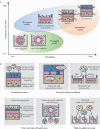Organoid-based Models to Study the Role of Host-microbiota Interactions in IBD
- PMID: 33341879
- PMCID: PMC8256633
- DOI: 10.1093/ecco-jcc/jjaa257
Organoid-based Models to Study the Role of Host-microbiota Interactions in IBD
Erratum in
-
Correction.J Crohns Colitis. 2023 Jan 27;17(1):149. doi: 10.1093/ecco-jcc/jjac104. J Crohns Colitis. 2023. PMID: 35971821 Free PMC article. No abstract available.
Abstract
The gut microbiota appears to play a central role in health, and alterations in the gut microbiota are observed in both forms of inflammatory bowel disease [IBD], namely Crohn's disease and ulcerative colitis. Yet, the mechanisms behind host-microbiota interactions in IBD, especially at the intestinal epithelial cell level, are not yet fully understood. Dissecting the role of host-microbiota interactions in disease onset and progression is pivotal, and requires representative models mimicking the gastrointestinal ecosystem, including the intestinal epithelium, the gut microbiota, and immune cells. New advancements in organoid microfluidics technology are facilitating the study of IBD-related microbial-epithelial cross-talk, and the discovery of novel microbial therapies. Here, we review different organoid-based ex vivo models that are currently available, and benchmark their suitability and limitations for specific research questions. Organoid applications, such as patient-derived organoid biobanks for microbial screening and 'omics technologies, are discussed, highlighting their potential to gain better mechanistic insights into disease mechanisms and eventually allow personalised medicine.
Keywords: in vitro models; Inflammatory bowel disease; microbiota; organoids.
© The Author(s) 2020. Published by Oxford University Press on behalf of European Crohn’s and Colitis Organisation.
Figures
Comment in
-
Letter to the Editor.J Crohns Colitis. 2022 Nov 23;16(11):1792-1793. doi: 10.1093/ecco-jcc/jjab225. J Crohns Colitis. 2022. PMID: 35073577 No abstract available.
References
-
- Geremia A, Biancheri P, Allan P, Corazza GR, Di Sabatino A. Innate and adaptive immunity in inflammatory bowel disease. Autoimmun Rev 2014;13:3–10. - PubMed
-
- Neurath MF. Host-microbiota interactions in inflammatory bowel disease. Nat Rev Gastroenterol Hepatol 2020;17:76–7. - PubMed
-
- Peterson LW, Artis D. Intestinal epithelial cells: regulators of barrier function and immune homeostasis. Nat Rev Immunol 2014;14:141–53. - PubMed
Publication types
MeSH terms
Grants and funding
- Earlham Institute
- 1S49419N/Research Foundation Flanders
- BB/R012490/1/Gut Microbes and Health
- Belgian IBD Research and Development [BIRD]
- CREA/12/031/CREA
- ZKC4621/10143459/European Crohn's and Colitis Organisation
- BBS/E/F/000PR10353/BB_/Biotechnology and Biological Sciences Research Council/United Kingdom
- BBS/E/F/000PR10355/BB_/Biotechnology and Biological Sciences Research Council/United Kingdom
- BB/J004529/1/BBSRC
- BB/M011216/1/BBSRC Norwich Research Park Biosciences
- Quadram Institute



